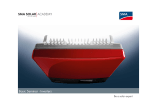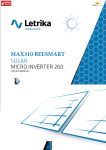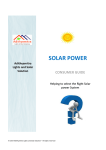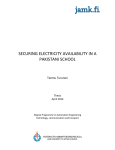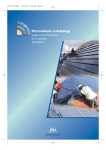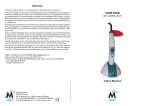Download The FP7 BeyWatch European scientific project: general
Transcript
The FP7 BeyWatch European scientific project: general features and design criteria of the Combined Photovoltaic Solar (CPS) system within the BEYWATCH system architecture G. Fertitta, C. Giaconia, D. La Cascia, F. Lo Bue, R. Miceli IEEE Member, C. Rando Università di Palermo - Dipartimento di Ingegneria Elettrica, Elettronica e delle Telecomunicazioni Italy Parco d’Orleans, Viale delle Scienze s.n.c. – 90128 Palermo (Italia) [email protected] Copyright © 2011 MC2D & MITI Abstract: This paper includes the general features and design criteria of a combined photovoltaic solar system (CPS) and its allocation within the entire architecture of the BeyWatch system. The CPS main functionalities and characteristics, the description of the CPS main components and the CPS electronic control and monitoring subsystem, together with the description of the Firmware design and communication protocols are here reported. The Combined Photovoltaic and Solar system (CPS) is a Renewable Energy system that produces thermal and electrical energy and the design has been based on a modular approach. Keywords: BEYWATCH (Building EnergY WATCHer), CPS (Combined Photovoltaic Solar) System, grid, hot water, electrical energy, ZigBEE, Wireless Sensor Networks. 1. Introduction Targeting environmental sustainability, energy efficiency and new power distribution production business models, BeyWatch research European project has designed, developed and is evaluating an innovative, energy-aware and user-centric solution, able to provide intelligent energy monitoring - control and power demand balancing at home-building & neighbor level [1]. The system interconnects legacy professional - consumer electronic devices with a new generation of energy-aware white-goods, where multilevel hierarchic metering, control, and scheduling are applied, based on power demand, network conditions and personal preferences. Moreover, via a combined photovoltaic - solar system, it is able to produce hot water and electric energy, which can be used at home or at peak hours fed to the electricity network [2]. Besides the research and technological objectives, BeyWatch has built one user centric energy delivery, consumption and production platform, is able to motivate a gradual change in the every-day energy consumption patterns of the typical consumer, towards a smoother power demand curve, and much reduced energy waste, while on the other hand, to enable new business models and flexible power consumption - generation contracts, creating new social interaction and targeting social acceptance of energy efficient buildings. One component of the BeyWatch platform is constituted a Combined and Photovoltaic System (CPS) made of both photovoltaic panels (for electricity) and solar panels (for hot water) [3]. This paper deals with the design and the set up of a new small scale CPS system which has been prototyped, optimized and integrated in BeyWatch architecture. The prototype is able to integrate the electric energy generation with the hot water production. The CPS provides an important step beyond state of art by implementing the following features: Integrate the thermal and electric energy generation to increase energy efficiency in its consumptions in household appliances; Integration, by means of massive ICT employment, with energy-aware white goods for providing sanitary hot water also for those devices; Integration with BeyWatch architecture for implementing energy management rules [4]. BeyWatch in-home architecture is shown in the following Figure 1. 2. CPS general features, design criteria and architecture [5] The general features and design criteria of the CPS are the following. Minimizing CPS Occupied Area: the CPS panels footprint have been designed so that it’s surface is as small as possible and with this aim the CPS system components have been chosen with the highest efficiency ratio. Taking advantage of incentives: the CPS plant allows the final user to enjoy the use of incentive tariffs so all the CPS components meet quality certifications and target minimum efficiency during their life cycle. Moreover the integration with existing home plants respects National and European technical standards. Having a fully architectural integration: the PV panel must be well integrated from an architectural point of view in order to preserve the home appearance, especially in some protected or historical areas. Infact, in many countries the integrated plants receive more incentives than the non-integrated ones. Minimizing CPS plant cost and investment payback period: the investment cost must be recovered in the shortest period of time so the designed smart CPS system allows either a faster investment retrieving, either a reduction of the components cost. Reaching compatibility: The CPS is compatible with existing home electrical and water networks. So the CPS is compatible with the most diffused existing home plants, especially waterworks. Having clear User Manual and Maintenance Scheduling: a clear user manual have been provided in order to allow the user to operate the system, to easily identify its malfunctions and to define the frequency and the quality of maintenance services. The in-home components of the BeyWatch system are: the Combined Photovoltaic and Solar (CPS) system; the BeyWatched Washing Machine; the BeyWatched Dishwasher; the BeyWatched Refrigerator and Freezer; the Smart Metering Device; the Electricity Watchers; The BeyWatched Residential Gateway; A conceptual overview of the Figure 1: The CPS in-home components in BeyWatch architecture 3. CPS main functionalities and characteristics The Combined Photovoltaic and Solar system (CPS) is a Renewable Energy System (RES) that supplies hot water for the in-home energyaware white goods, mainly in order to reduce or to cancel the internal heating cycles, and for general sanitary use; this strongly reduces the home electrical energy utilization and CO2 emissions, as a direct consequence [6]. The CPS also generates electrical energy to be used under the user/agent control and thanks to its high performance ICT features that allow a strong communication between the PV system, the solar system and the Agent, - into the home in order to decrease electric energy requests from the grid during the peak times or when electrical energy may become too expensive. The generated electrical power can be fed into the electrical distribution network or, depending on the business model adopted by energy providers, it can eventually end up in a direct profit for the user. The preferred “destination” of the generated electricity is explicitly dependant on specific regional market constraints (France, Spain, Italy, etc.): the BeyWatch platform takes into account this flexibility requirements [7]. The CPS design has been based on a modular approach whose minimum cell considers a PV (photovoltaic) panel with about 1kWp of nominal peak electrical power. As for the thermal production, the CPS considers a modular design based on a 200 liters hot water tank within a temperature range spanning between 35° and 75°C. These values can be changed according to the amount of needed thermal and/or electrical energy and on the CPS physical location. The CPS behaves as an intelligent module, able to communicate with the BeyWatch Agent, via a wireless medium, in order to act according to energy management rules. The internal control logic has been based on low power embedded microcontrollers thus providing the needed processing power to control the CPS relevant parameters, to log all of them for a minimum required time interval and to implement the wireless communication with the Agent [5]. In particular, electrical energy from the PV panel can also be used to heat water in case of hot water demand. This is done according to the decisions taken by the BeyWatch Agent. All the above described functions have been implemented with a single microcontroller based board, acting as a master board and in charge of all the communications with external elements to the CPS. Two slave boards responsible for the control and the logging actions on the CPS subsystems such as the Photovoltaic panel, the Solar collector, the hot water Tank etc. The slave boards will also be processor based and will internally communicate with the master board via a wired medium. The CPS system functionalities are presented in Figure 2. Figure 2: CPS system functionalities 4. CPS components description The CPS is made up by a PV system and a Solar Thermal (ST) System. The main components of the PV system are the PV panel and the PV Inverter, while the main components of solar thermal system are the Solar Collector, the solar station and the solar Tank. The PV panel consists of a system able to produce about 1300 Wp max electrical power. The PV inverter is grid connected and synchronizes to the AC grid electrical frequency. The inverter is equipped with a Maximum Power Point Tracking (MPPT) system able to maximize the power generated. The Solar Collector (also called “S-T panel”) is able to heat the water inside the solar tank up to a temperature of 75 °C. The total solar collector surface is of about 6.6 square meters and is composed of two modules. The solar station is able to implement the forced circulation of the thermo vector fluid inside the solar collector and the tank for its temperature control. A. The PV System. It is constituted of a string made of six series connected modules. Each module has a peak power equal to 220Wp with 3% power tolerance. Each module has the following dimensions: 1580 mm (L) x 808 mm (W) x 35 mm (H) The PV panel string supplies a 2 kW static DC/AC power converter. The static power converter actuates the synchronization of the PV voltage and frequency with the grid ones. The table hereafter reports the PV system technical specifications. The PV system is also equipped with a pyranometer able to detect the solar irradiation that enables the Agent to connect the electric power generation historical data with the in-home energy consumption. The string picture and the static power converter picture of the PV system realized are reported in Figures 3 and 4. B. The ST (Solar Thermal) System. The ST system is constituted by two solar collector modules of the EKOS factory model DS – 24. Each module solar having a whole net surface equal to 3,3 m2 and is constituted by 24 heat pipes.Table 2 reports the ST system technical specifications. The heat pipe dimensions are 58 mm of diameter and length equal 1800 mm. The ST collector schemes are reported in the Figure 5 and Figure 6, the ST tank scheme is reported in Figure 7 while the hydraulic connection scheme is shown in the Figure 8. In Figure 9 the installed solar collector system is shown while in Figure 10 the solar tank and the solar station are reported. Table 1: PV system technical specifications # 6 1 1 2 10 m 1 Description Mono-crystalline Silicon Solar Modules: maximum power 220 W, Power tolerance 3%, maximum power voltage 37,5 V, maximum power current 4,95 A, open circuit voltage 44,5 V, short circuit current 5,40 A, maximum system voltage DC 1000 V (TUV). Specification at STC: 1000W/m2 solar irradiance, air mass coefficient (AM) 1,5, 25°C cell temperature. All electrical specifications are +/3%. Static power converter: DC Input Parameters: Maximum DC voltage system 600 V, DC rated voltage 360 V, MPPT voltage range 90 – 580V, rated current 10 A, maximum short circuit current 12 A. AC Output Parameters: AC rated voltage 230 V, AC rated frequency 50 Hz, maximum output current 10 A (rms), rated AC power 2000 W at 40°C ambient temperature, maximum over current protection 16 A. Range operational temperature from -20°C to +55°C. International Protection (IP65) Frame for the modules anchorage on horizontal roofs are equipped with ballast, aluminium modules frame work, attaching system and brackets. Multicontact connectors pairs DC Solar cables 2x4mm2 pyranometer Figure 7: The tank scheme Figure 3: The string picture of the PV system Figure 8: The hydraulic connection scheme Table 2: ST system technical specifications Figure 4: The PV system static power converter Figure 5: The module front scheme of the ST solar collector Figure 6: The solar collector module lateral scheme # Description 2 Modular Vacuum Solar collector, model DS - 24: Each modular collector has aperture area 3,3 m2 with 24 heat pipes, each heat pipe dimensions is 58 mm (diameter) and 1800 mm (length). 1 Temperature Probe for the Vacuum Solar collector 2 Temperature Probe for the Solar tank 1 Solar tank: 200 liters capacity, rigid polyurethane insulation, 1380mm height, 550 mm diameter, pressure range from 0 bar to 8 bar, maximum pressure 12 bar, maximum temperature 95°C, mixing coefficient 12%, internal exchanger with 1m2 surface. 1 Solar station (Back device with solar gear case): - Safety and insulation systems for the pipes; - circulation pump, - safety valve 6 bar, - manometer 10 bar, - water faucets, - thermometers, - flow rate measurer. 2 Fastener clamp for horizontal roof 2 Expansion tank 18 liters 30 Antifreeze for vacuum solar collectors l 1 Thermostatic valve 1 Safety valve for sanitary hot water 6 BAR 1 Electric Resistor 230 W, single phase feeding. 1 Electric board for the electric resistor driving including a single phase differential magnetothermic 16 A switch 1 Steel Solar pipes The connection scheme of the PV generator to the public low voltage grid is reported in Figure 11 according to the CEI 11-20 standard. Table 3 summarizes the measures which are monitored on the CPS system and which are logged to control it and which are sent to the BeyWatch Agent. Figure 10: The ST system Figure 9: The ST Solar Collector system. Table 3: CPS data to be monitored Measured quantity Temperature AC Voltage AC Current DC Current Temperature Temperature Measured abbreviation Tpv Vac Iac Icc Tst Tsc Solar irradiation S.i. Position on the CPS PV panel Inverter Inverter Inverter Solar Tank Solar Collectors Module Pyranometer 5. CPS electronic control and monitoring As already stated, the input data for the CPS are collected through several sensors located near the main parts of the system, by using a tailored designed and implemented slave boards. The Photovoltaic and Solar Thermal panels and the electric inverter and the hot water tank are likely placed on the roof of the authors’ Department. Thus the electronic master micro control and monitoring system acts as the main device responsible of the wireless communication with the agent via an integrated ZigBee transceiver [8], while two Slave Micro (located on the roof) send monitored data via an RS485 wired communication system implemented within the same microcontroller, to the receiving Master micro that in turn collects them to be ready for the BeyWatch agent upon request. From the hardware point of view, the CPS is composed by three boards with the following characteristics and equipments: Master Micro Board: ZigBee transceiver, 8051 based micro controller and RS 485 Transceiver. Slave Micro 1 - Boiler Board : 4 ADC inputs for Temp. sensing, 1 Electric Heater Bypass Circuit, 1 On/Off circuit for electric heater, 8051 based micro controller and RS 485 Transceiver. . Figure 11: The connection scheme of the PV generator to the public low voltage grid Slave Micro 2 – Photovoltaic Board: 1 ADC input for Temperatures sensing, 1 ADC input for PV AC current sensing, 1 ADC input for PV AC Voltage sensing, 1 ADC input for Solar radiation sensing, 1 ADC input for PV DC panels current sensing, 8051 based micro controller and RS 485 Transceiver. ach board is then subdivided in two daughter parts, the sensing board and the controller board. The controller board is mounted on the sensing board by an embedded socket This allows the realization of a unique controller board by giving to the sensing board all the custom circuits and conditioning electronics dedicated to a particular slave micro and leaving to the controller board the AD conversion functionalities and the elaboration step within the embedded microcontroller. The controller board in fact integrates the TI CC2531 micro controller which provides the ADC inputs and the RF transceiver. The sensing boards instead integrate the signal conditioning circuits and the serial RS485 transceiver. Moreover, each sensing board integrates two voltage regulators, in order to provide a stabilized 5V and 3,3V DC power supply. Although the slave and master boards provide different sensing circuits, the power circuit, the RF transceiver socket and the serial interface, are identical. Figure 12 shows a picture of the implemented controller board. Figure 13: CPS Monitor screenshot 7. Conclusions Figure 12: RF controller Board (Top view) 6. Firmware design and communication protocols The CPS internal logic is primarily dependent on the communication state between the Master Micro and the Agent. Even if the boards are capable to implement a ZigBee node, all their parameters are visible to the agent through the Master Micro as a unique information source for the CPS as a whole. Moreover all the implemented methods follow the public defined ones of the Home Automation standard Cluster of the Stack, hence the CPS is a full interoperable ZigBee wireless node. The main scenarios correspond to presence or not of a wireless communicating link between agent and CPS control electronic When all is rightly working the CPS Logic runs all the commands coming from the Agent, this is in fact the most efficient way of behaving, since the CPS has no direct connection with the appliances requests neither it can predict possible electricity and/or hot water usage from the generic loads of the apartment. The only command to be given to the CPS is then: Set the target temperature for the hot water tank (Tset). In this way the Agent may independently decide the tank Temperature and, if needed, the electric resistor will be locally controlled by the Slave board in order to speed up the tank heating phase. When instructions do not arrive from the Agent, due to communication link failure, the CPS internal electronic control system assumes a minimum service temperature (Tbasic) as a reference, acting as in a traditional system. As an example a screenshot of a working CPS monitoring interface is shown in Figure 13, where more parameters than the ones strictly needed for the BeyWatch Agent-CPS communication are present. Some of them in fact are also locally monitored by the CPS control electronics in order to internally check the correct CPS working conditions. The above described CPS has been successfully tested both from the hardware point of view, by considering the functionalities of the single Photovoltaic and Solar Panel, and from the ICT point of view, by implementing the electronic interface and running test about all the monitored parameters and collecting them within a simplified agent integrated within a portable PC. CPS continuous data logging is now routinely set up in order to observe long term behavior of the whole system. Acknowledgement This publication was partially supported by the Project BeyWatch IST-223888, which is funded by the European Community. This work was realized with the contribution of SDES (Sustainable Development and Energy Savings) LaboratoryUNINETLAB - University of Palermo and MIUR. References [1] www.beywatch.eu; [2] Beywatch White Paper at www.beywatch.eu; [3] G.C. Giaconia, G. Fiscelli, F. Lo Bue, A. Di Stefano, D. La Cascia, R. Miceli, “Integration of Distributed on Site Control Actions via Combined PhotoVoltaic and Solar Panels System”, ICCEP 2009 International Conference on Clean Electrical Power - Capri, Italy, 9-11 June 2009; [4] R. Miceli, D. La Cascia, A. Di Stefano, G. Fiscelli, C. Giaconia "Impact of Novel Energy Management Actions on Household Appliances for Money Savings and CO2 Emissions Reduction", EVER 09 Electrical Vehicle and Renewable Energy international conference, Montecarlo 26th - 28th march 2009; [5] Deliverable D3.4 “Combined Photovoltaic/Solar prototype”, BEYWATCH (Building EnergY Watcher) Project no. FP7ICT- 223888, May 2010; [6] Miceli et. Al: “Energy Management via connected household appliances” Mc. Graw & Hill ISBN 978-88-386-6676-6; [7] Deliverable D5.3 “Specification of the BeyWatch BSS architecture and components”, BEYWATCH (Building EnergY Watcher) Project no. FP7-ICT- 223888, March 2010; [8] http://focus.ti.com/lit/ds/symling/cc231.pdf.







